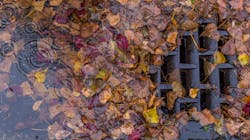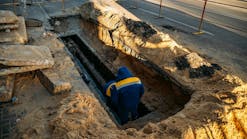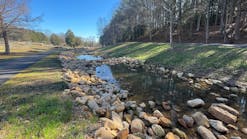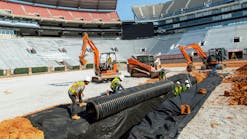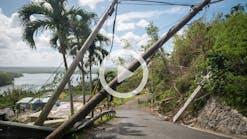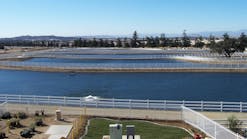Navigate leaf litter challenges & reduce the impact on stormwater quality
Autumn is here, so it is time for stormwater professionals to become proactive about reducing the season’s effects. That may mean assigning more staff members to reduce the amounts of fall leaves in storm drains or installing permeable pavements in areas known for above-average buildup. Giving residents fall stormwater tips is also advantageous because it lets the public play an important role in their neighborhoods.
The impact of fall leaves in storm drains
Many people probably think fall leaves in storm drains are merely eyesores. However, stormwater quality professionals are in an excellent position to explain that the issues span beyond aesthetics. That is particularly true in urban areas.
The grassy fields and dirt roads in the countryside allow stormwater to soak into the Earth. However, since urban areas have more non-permeable surfaces — such as concrete — rainwater and liquid from melted snow can pollute waterways. That also becomes more likely because contaminants frequently mix into the storm remnants, causing additional issues.
Firstly, they can clog storm drains, increasing the chances of flooding. Plus, decomposing leaves add nitrogen and phosphorus to stormwater. The effects promote cyanobacterial blooms, creating public health hazards and threatening wildlife. Those nutrients also cause oxygen depletion in waterways that kill fish. They can also allow invasive aquatic plants to flourish, leading to far-reaching ramifications in the area.
Professionals should focus their fall stormwater tips on these broad and preventable issues. Most residents should respond favorably to them, especially with more people wanting to do what they can to support sustainability.
Investigate green infrastructure options
Many architectural professionals have taken inspiration from nature to improve energy efficiency or achieve other gains. People managing stormwater runoff and the challenges of autumn leaves can do something similar by determining how green infrastructure might support their aims.
This approach can pay off in significant ways. Consider how green infrastructure in Indianapolis saved more than $300 million in material-based costs using a smaller-diameter pipe.
However, as you explore the possibilities and attempt to secure the budget for implementation, it is also necessary to be mindful of how to get the most equitable results. Researchers from Portland State University examined the impact of rainwater flooding in several major cities with green infrastructure. Their findings revealed the risks were greater for non-white and low-income groups in those areas.
Elsewhere, a University of Cincinnati team studied some common green infrastructure options that tackle excessive groundwater. They evaluated possibilities such as detention basins and bioretention cells, and their usefulness in five settings.
The results showed detention basins worked best for areas where the ground surface is at least 70% impervious. However, in locations where the total impervious surface is less than 40%, the researchers believe low-impact development practices are better for reducing the overall flood risk.
One project in American Samoa also highlighted how community rain gardens can be excellent teaching tools that prevent flooding complications. An initiative taught dozens of attendees how to install rain gardens with do-it-yourself plans. Regardless of which green infrastructure options people choose, they should always include responsible efforts to address fall leaves in storm drains.
Combine education with convenience
Giving people fall stormwater tips is important, but this strategy will most likely pay off if residents feel it is easy to follow the best practices. The best way to create such circumstances is to make it convenient for people to do the right thing with their raked leaves.
In one area of Washington State, residents can print leaf coupons that allow them to bring up to 5 cubic yards of them to four disposal sites for free. That program reinforces the idea of not associating a financial burden with responsible leaf disposal.
An Illinois city has a program where people can have garbage collectors take contained leaves away as part of curbside pickup routes. That is helpful because people can get rid of their leaves responsibly and build the activity into getting their trash bagged properly for removal.
Since many cities have public leaf schedules lasting several weeks, some officials provide apps. People can use them to learn pick up dates or even get notified a few days before.
Emphasize how leaf disposal brings personal advantages
Even as stormwater professionals spend their careers thinking about how fallen rain, snow and leaves can affect water quality, those issues are a bit too far removed from residents’ everyday lives. The key is highlighting specific situations where fall leaves in storm drains cause effects most people do not immediately bring to mind.
The first is clogged catch drains make neighborhoods more susceptible to flooding. Then, the aftermath of rain and snowstorms becomes more severe for everyone in the area. Failing to manage the issue could lead to property damage and safety hazards.
These are some reasons why officials may run drain-cleaning programs for local businesses at discounted rates. Other initiatives encourage residents to keep an eye on the catch drains, cleaning them out when they become clogged.
Keeping fallen leaves under control also makes the roads safer for people using bicycles and motorcycles. That is primarily because residents often rake leaves into piles that block designated paths. As those leaf mounds become wet and decompose, they pose safety hazards for several reasons.
Firstly, people on bikes may need to go into traffic to steer around them. The height and width of the piles may make it difficult for people to see fellow road users or obstacles. Finally, if the piles are small enough, bikers may try to ride through them. But that decision is risky because the leaves become so slippery. If bike wheels do not have the necessary traction, people will quickly lose control — which becomes more dangerous at even a moderate speed.
Apply fall stormwater tips to benefit from best practices
These suggestions show leaf management is a collective effort from professionals and residents. It is also helpful that preventing leaves from harming water quality is a concern of people from any location with significant tree coverage. That means there are plenty of examples of programs and practices city officials and other professionals have tried. The final thing to remember is the best results typically occur with a combination of methods instead of hoping one will be sufficient.
Emily Newton | Editor -in-chief
Emily Newton is editor-in-chief of Revolutionized. Newton can be reached at [email protected].
